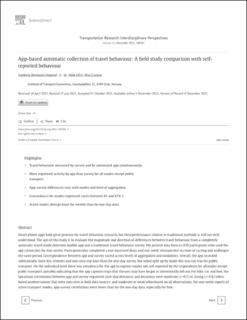| dc.contributor.author | Hesjevoll, Ingeborg Storesund | |
| dc.contributor.author | Fyhri, Aslak | |
| dc.contributor.author | Ciccone, Alice | |
| dc.coverage.spatial | Norway, Oslo | en_US |
| dc.date.accessioned | 2023-06-20T12:56:41Z | |
| dc.date.available | 2023-06-20T12:56:41Z | |
| dc.date.created | 2021-12-06T14:49:05Z | |
| dc.date.issued | 2021-12-04 | |
| dc.identifier.citation | Transportation Research Interdisciplinary Perspectives (TRIP). 2021, 12 (December 2021), 1-17. | en_US |
| dc.identifier.issn | 2590-1982 | |
| dc.identifier.uri | https://hdl.handle.net/11250/3072314 | |
| dc.description | Ingeborg Storesund Hesjevoll, Aslak Fyhri, Alice Ciccone, App-based automatic collection of travel behaviour: A field study comparison with self-reported behaviour, Transportation Research Interdisciplinary Perspectives, Volume 12, 2021, 100501, ISSN 2590-1982, https://doi.org/10.1016/j.trip.2021.100501 (https://www.sciencedirect.com/science/article/pii/S2590198221002062) | en_US |
| dc.description.abstract | Smart phone apps hold great promise for travel behaviour research, but their performance relative to traditional methods is still not well understood. The aim of this study is to evaluate the magnitude and direction of differences between travel behaviour from a completely automatic travel mode detection mobile app and a traditional travel behaviour survey. We present data from n = 230 participants who used the app (sense.dat) for four weeks. Participants also completed a one-day travel diary and one-week retrospective account of cycling and walking in the same period. Correspondence between app and survey varied across levels of aggregation and modalities. Overall, the app recorded substantially more km, minutes and non-zero trip days than the one-day survey, but when split up by mode this was not true for public transport. On the individual level there was a tendency for the app to register modes not self-reported by the respondents for all modes except public transport, possibly indicating that the app captures trips that the user may have forgot or intentionally left out. For bike, car and foot, the Spearman correlations between app and survey registered (one-day) distances and durations were moderate (r > 0.5) or strong (r > 0.8) when based on observations that were non-zero in both data sources, and moderate or weak when based on all observations. For one-week reports of active transport modes, app-survey correlations were lower than for the one-day data, especially for foot. | en_US |
| dc.language.iso | eng | en_US |
| dc.publisher | Elsevier | en_US |
| dc.rights | Attribution-NonCommercial-NoDerivatives 4.0 Internasjonal | * |
| dc.rights.uri | http://creativecommons.org/licenses/by-nc-nd/4.0/deed.no | * |
| dc.subject | Travel behavior | en_US |
| dc.subject | Smartphone application | en_US |
| dc.subject | Self-report | en_US |
| dc.subject | Travel survey data collection | en_US |
| dc.title | App-based automatic collection of travel behaviour: A field study comparison with self-reported behaviour | en_US |
| dc.type | Journal article | en_US |
| dc.type | Peer reviewed | en_US |
| dc.rights.holder | © 2021 The Author(s). Published by Elsevier Ltd. | en_US |
| dc.source.articlenumber | 100501 | en_US |
| dc.description.version | publishedVersion | en_US |
| cristin.ispublished | true | |
| cristin.fulltext | original | |
| cristin.qualitycode | 1 | |
| dc.identifier.doi | 10.1016/j.trip.2021.100501 | |
| dc.identifier.cristin | 1965158 | |
| dc.source.journal | Transportation Research Interdisciplinary Perspectives (TRIP) | en_US |
| dc.source.volume | 12 | en_US |
| dc.source.issue | December 2021 | en_US |
| dc.source.pagenumber | 1-17 | en_US |
| dc.relation.project | Norges forskningsråd: 267855 | en_US |

